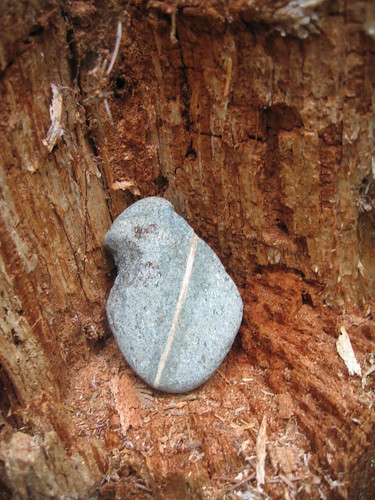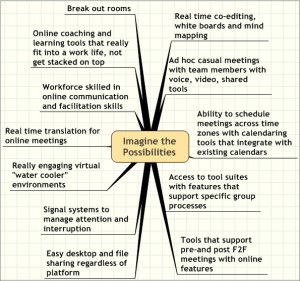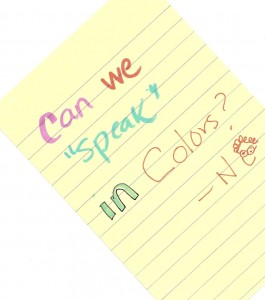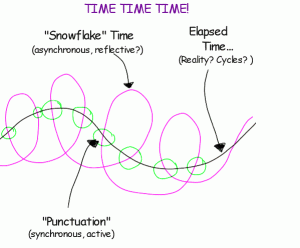 Warning: long, rambly post that is more for the FLNW network than many of you, dear readers. But it is something I owe, and because of the nature of the network, I owe it publicly. This is not mine to hold close in an email thread.
Warning: long, rambly post that is more for the FLNW network than many of you, dear readers. But it is something I owe, and because of the nature of the network, I owe it publicly. This is not mine to hold close in an email thread.
I was hugely appreciative that Michael Coglan, Robyn Jay and Stephan Ridgway took some time to make a podcast with Michael about the August FLNW (Future of Learning in a Networked World) road trip here in the Pacific Northwest of the US. It put an item that had been languishing on my to do list higher in the queue – blog about the week. I did a quick post while on the road, but it took all my attention to keep the logistical wheels on the road trip “bus” (my minivan and Sylvia’s SUV), plus I had just gotten over a bug that I now think may have been a mild case of the H1N1 viruas. Go figure!
Anyway, the podcast and rereading this thread from our email list has me trying again to express what I learned and what I am still feeling. So much of that learning is still half cooked. I don’t know if I can even express it at all. Some of it is intellectual. Some emotional and some may be or should be more private and personal. Oh well… worth a try.
I had a wonderful time with Sylvia Currie, Leigh Blackall, Derek Chirnside, Sunshine Connelly, and Michael Coghlan, and loved, as always, the beauty of my region. We traveled in two vehicles, me meeting the gang rolling down from Vancouver B C after the Open Ed conference. We hooked up in Mount Vernon, Washington, made the mad dash to the ferry on Whidbey Island to Port Townsend (after missing our reservation time… we were one of the last on a much later ferry!), and stopping the first night in Port Angeles. From there we went on to Forks and finally, Menlo, Washington, ending up in Seattle. You can see the travel bits on the wiki and Flickr pictures.
Somehow, I want to share what I learned from our conversations about learning in a networked world and what I continue to learn about group process in this little groups process (or sometimes lack of process!) It is in the latter that I’m still muddling and a bit uncomfortable. So I’ll start with the uncomfortable.
After listening to the podcast, particularly the observations and questions of Robyn and Stephan, i took time to comment. My comments on the podcast post start to surface my concerns and complicity. This was my very long comment on the podcast. Yeah, rambly. But I warned you, right?
Thank you so much for making and sharing this conversation. I’m in the midst of writing up a long-overdue blog post. This helps urge me forward. I have been resisting because I have some conflicting feelings and am concerned about how I express them – because they are all double edged swords. How much sweetness, how much sting and how much time to thoughtfully and honestly express both. I also realized that so many of our conversations were quite personal, and I have been cogitating on how to transfer the learnings of those conversations without trespassing on the beauty of some of the personal nature of the conversations and what should be maintained in that boundary. It takes a lot of time. I’ve been avoiding it.
First, it was pretty heartbreaking to hear the disappointment. Because I personally feel I let you down, and also because I share some of that disappointment. So the combo of responsibility, guilt … haha. You know how much fun that is!
At the same time, I don’t want to let that disappointment diminish the quality of the time together for those of us on the road. So there are clearly conflicting feelings in me.
I want to add one part here very specific around the end of the podcast around roles, responsibilities and decisions. Michael said Sylvia and I didn’t mind making the decisions etc.
I’d like to express that it was uncomfortable and at times I did mind. And certainly I worried about it. I felt I prodded and prodded with little response from the group, but Sylvia and I were the newbies in the group. Maybe we didn’t know something they experienced guys knew, eh? I can be a very pushy and action oriented person by nature. I was trying to be very careful not to “drive” things (and annoy the crap out of everyone!) Believe me, I can annoy the crap out of everyone. I have been given specific feedback from dear and close friends that I can also “take up too much space” in conversations etc. There were certainly moments where I was aware of this. (I;m writing this with a smile. I am hoping the others in the group read this with a smile!)
In July I told Sylvia I was concerned. I thought the rest of the gang were not concerned about substance or focus beyond Derek, and he let that go (I’m guessing because no one else took him up on his ideas?). Why were no other folks wanting to join in? Was the “sustainability” theme just hot air? There seemed to be little engagement. It was “we’ll show up and it will happen. ” OK. that was not what I thought FLNW was about.
At some point I was chafing because I didn’t want to be just a tour guide and I *did* want to be a host of a learning adventure/journey/conversations. I felt quite odd making so many decisions because, while local knowledge helps inform options, it does not privilege decision making. I was truly happy to facilitate the logistics and help provide the transportation. Absolutely. But what about the ‘heart” of things? How would that happen?
I did not express that well, if at all. This is the sad sign of a facilitator facilitating facilitators. I said at one point to Michael that this is always a bad combo! LOL. We tend to ignore our own advice.
At that point, I made the personal decision to simply go with the flow. If there was no energy to plan, act, lead, decide, then it would happen as it would happen. Getting sick the week before only solidified my approach. There was literally no energy available.
This was an essential key for me to be able to both a) go and b) enjoy it in any way. Selfish? probably. Realistic? absolutely.
I had to let go of guilt about not hooking in with the wider community (Sylvia made that happen w/ Marsha and I with Potluck farm – by the way, my sense of the conversations was that they were about learning, not about education under the guise of talking about organic farming. But wow, that was one of the places where the conversations were also VERY political.) It was where I personally let go of focus and thus any sort of scaffolding for reporting out, pulling in and engaging with the rest of the network. This is the key for me. To engage with the wider network, we need some minimal scaffolding. It can be VERY flexible, but it holds us accountable.
My experience was that there was a very strong message from Leigh that he felt we had no obligation and this WAS a vacation. He was not accountable. And Leigh, you know, has a strong voice. 🙂 The rest of us seemed to follow that like sheep, eh?
So as a fabulous trip with wonderful people with terrific conversations, beautiful scenery, lovely shared walks and meals – it was a total YES YES YES. As a node off of a wider network, as a contribution, not just a feast for ourselves, I think it was a NO NO NO. We didn’t make that work.
Do we need to grant ourselves slack to do something that was primarily (or all) internally focused.
At the least, we owe it to each other to be clearer about expectations on all sides (I did not hear too much clamoring from the rest of the network beyond 3 people if memory serves…), to be honest about what we are and aren’t willing to do (Leigh gets kudos for declaring he was on vacation), and the courage to speak up and hear each other deeply and thoughtfully.
A week later after that comment I feel a bit clearer in expressing my learnings. As usual, they come in the form of some questions for me around process (yes, I’m a process queen):
- When a subset of a loose network (FLNW) does a face to face roadtrip, what are the implicit and explicit obligations to report out and hook up with the wider community? Should this be negotiated? Or just let it happen? Is it “who speaks loudest” from both within the trip group and the wider network guide us? What about those in the wider network who did not speak up? How much reaching out should we do?
- How much or how little structure and process creates a fertile and enjoyable adventure like these road trips that accrues value beyond a fun holiday with friends?
- What decisions need to be made, who should make them and what are the implications? Or does it matter?
- What are our obligations to question process, and question each other when we think something ought to shift?
For me, this set of questions will be useful when I’m planning something similar in the future. I think it is totally legit to “let go” and just let things flow, but as I mentioned in my comment, it is useful when this is communicated to the wider network. Because I do feel an obligation, but that obligation must be balanced with the realities of any particular context.
 A DM Tweet today caused me to go and look and see what resources I’ve posted on the blog about
A DM Tweet today caused me to go and look and see what resources I’ve posted on the blog about 



 This obituary for
This obituary for